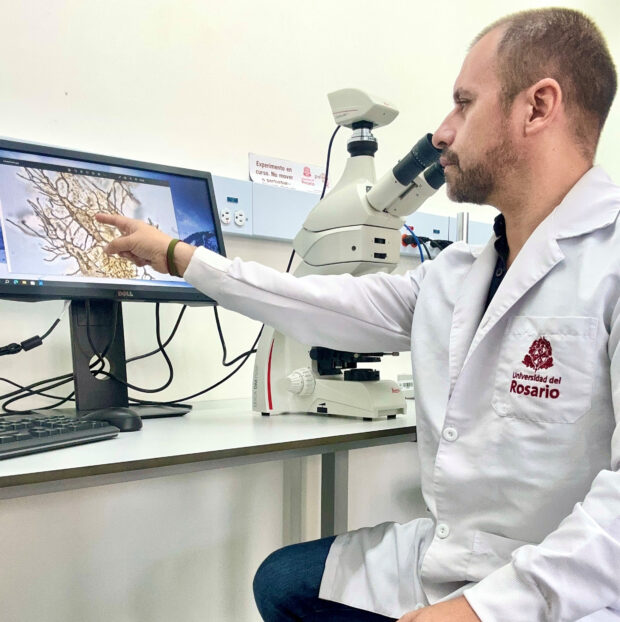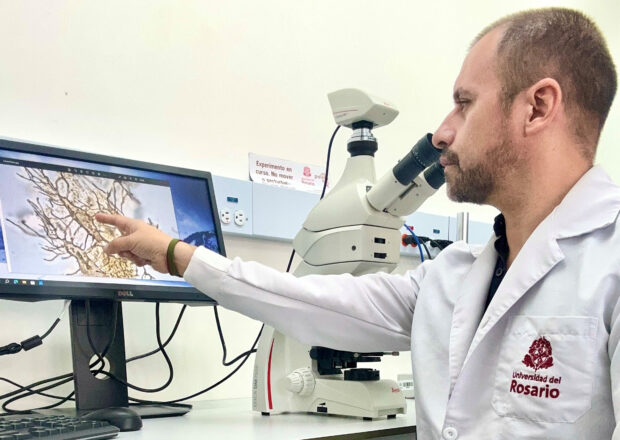
Professor at the University of Rosario (Universidad del Rosario) Edwin Cadena works at the laboratory, in Bogota, Colombia, in this picture taken on 2023. Edwin Cadena/via REUTERS
A groundbreaking discovery has been made in the field of paleontology. Researchers have found remnants of DNA in fossilized remains of a sea turtle dating back 6 million years, which is closely related to the modern Kemp’s ridley and olive ridley turtles. This is a rare occurrence, as genetic material is not commonly identified in ancient vertebrate fossils. The team of scientists unearthed the fossil along the Caribbean coast of Panama in 2015. While the skeleton is incomplete, the carapace, or shell, remains relatively intact. The sea turtle would have measured about a foot in length during its time of existence.
The researchers were able to identify well-preserved bone cells called osteocytes in the fossil. Some of these osteocytes still contained nuclei, and through a chemical solution, the scientists were able to detect traces of DNA. Edwin Cadena, the lead author of the study published in the Journal of Vertebrate Paleontology, clarified that the DNA itself was not extracted, but its presence was recognized in the nuclei of the cells. Cadena, a paleontologist from the Universidad del Rosario in Bogota and the Smithsonian Tropical Research Institute, explained the significance of this finding.
DNA is known to be highly perishable, but under the right conditions, it can be preserved in ancient remains. Previous studies have reported the discovery of DNA from animals, plants, and microbes dating back approximately 2 million years in sediment at Greenland’s remote northernmost point. However, the DNA remnants found in the sea turtle fossil are among the oldest ever recorded in vertebrate fossils. The only vertebrates with older DNA remnants discovered so far are two dinosaurs: Tyrannosaurus, which lived around 66 million years ago, and Brachylophosaurus, which lived around 78 million years ago. DNA remnants have also been found in insects dating back tens of millions of years.
The fossil belongs to the same genus, Lepidochelys, as two of the world’s living sea turtle species: the Kemp’s ridley and the olive ridley. The Kemp’s ridley, known for its triangular-shaped head and slightly hooked beak, is primarily found in the Gulf of Mexico. The olive ridley is similar in appearance to the Kemp’s ridley and has a larger distribution, primarily inhabiting the tropical regions of the Pacific, Indian, and Atlantic oceans. The sea turtle fossil represents the oldest-known member of the Lepidochelys genus and provides valuable insights into the evolutionary history of this group of turtles.
Although the remains were too incomplete to identify the species of the ancient turtle, Cadena emphasized that each fossil has unique preservation conditions, some of which may favor the conservation of original biomolecular remains like proteins and DNA. He hopes that future studies will involve the sequencing of small fragments of DNA, enabling researchers to infer more information about the ancient sea turtle and its relatives.
RELATED STORIES
What sea turtles can teach us about survival
Love of sea turtles turns Philippine poachers into protectors
Denial of responsibility! Vigour Times is an automatic aggregator of Global media. In each content, the hyperlink to the primary source is specified. All trademarks belong to their rightful owners, and all materials to their authors. For any complaint, please reach us at – [email protected]. We will take necessary action within 24 hours.


